Bring on the Sequestration: US Dollar Surges as Austerity Hits Home
ASIA/EUROPE FOREX NEWS WRAP
What’s the best way to cure a spiraling budget deficit? - sweeping spending cuts and higher taxes, apparently. No, this isn’t some German-borne austerity package being jammed down the throats (and really, out of the pockets) of Greek or Italian consumers. Instead, it’s the brain child of Democrats and Republicans as part of the Budget Control Act of 2011, which pushed up the US debt ceiling in August 2011, shortly before the United States was stripped of its hallowed ‘AAA’ credit rating by Standard & Poor’s.
With no meaningful discussions occurring over the past several weeks, US lawmakers have bestowed the unfriendly gift of $85B in budget cuts today – all at once – as a result of failing to reach compromise to avoid the so-called ‘cliff.’ These are the first of $109B in budget cuts that will occur this year, mainly hitting defense spending, which already dropped by an annualized rate of -22.0% in the 4Q’12, as per the second release of the US GDP report yesterday.
While the moves in FX today by-and-large haven’t surprised me (I expected a flight to the safe havens; and the weak PMI data out of the Euro-zone and the United Kingdom has accelerated this move in the European currencies), I am a bit taken aback by price action in the Japanese Yen. Since mid-November, when it became clear that Shinzo Abe and his heavy dovish hand would dictate Bank of Japan policy going forward, the USDJPY has traded very closely to the 2s10s Treasury spread (the difference between the 10-year and 2-year note yields) as well as the S&P 500.
Thus, seeing the Yen struggle amid a pullback in equities and a clear reason for investors to seek safety – political issues weighing on the US economy amid new austerity, just as in Europe – is a surprise.
Taking a look at European credit, peripheral yields have compressed further today, despite a lackadaisical performance by the Euro. The Italian 2-year note yield has decreased to 1.826% (-7.6-bps) while the Spanish 2-year note yield has decreased to 2.425% (-2.5-bps). Likewise, the Italian 10-year note yield has decreased to 4.719% (-0.3-bps) while the Spanish 10-year note yield has decreased to 5.039% (-2.6-bps); lower yields imply higher prices.
RELATIVE PERFORMANCE (versus USD): 11:30 GMT
NZD: -0.08%
CAD: -0.14%
AUD: -0.19%
EUR:-0.21%
CHF:-0.37%
JPY:-0.38%
GBP:-0.90%
Dow Jones FXCM Dollar Index (Ticker: USDOLLAR): +0.39% (+0.35% past 5-days)
ECONOMIC CALENDAR
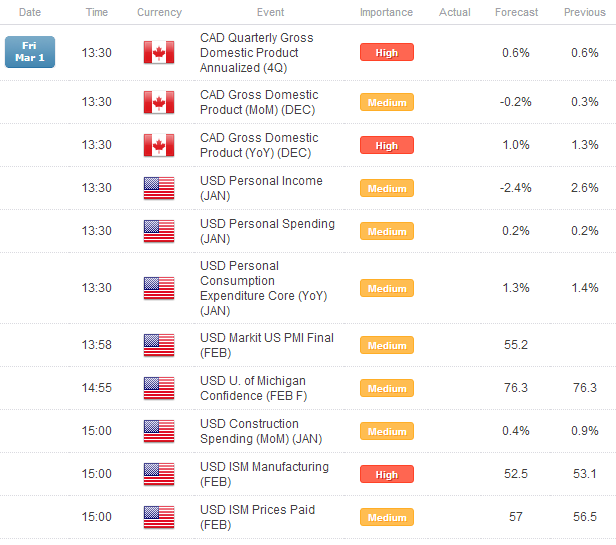
See the DailyFX Economic Calendar for a full list, timetable, and consensus forecasts for upcoming economic indicators.
TECHNICAL ANALYSIS OUTLOOK
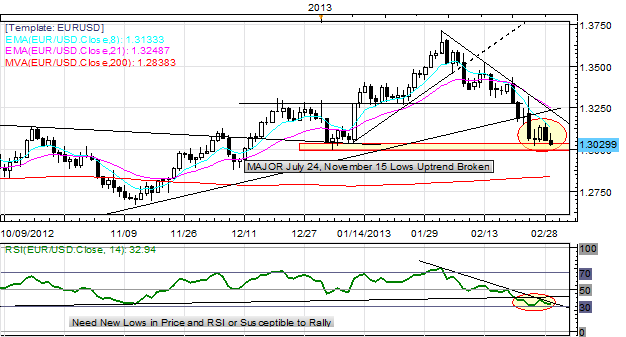
EURUSD: No change as the pair tests the 2013 lows: “The pair has broken the major uptrend off the July and November lows, breaking at 1.3200/20 yesterday, leading to a cataclysmic sell-off into the January swing lows at 1.2995/3035. Although the EURUSD is near oversold conditions, we note that momentum amid political distress tends to supersede RSI. If 1.2995 breaks, a move into 1.2875 and 1.2660 shouldn’t be ruled out.”
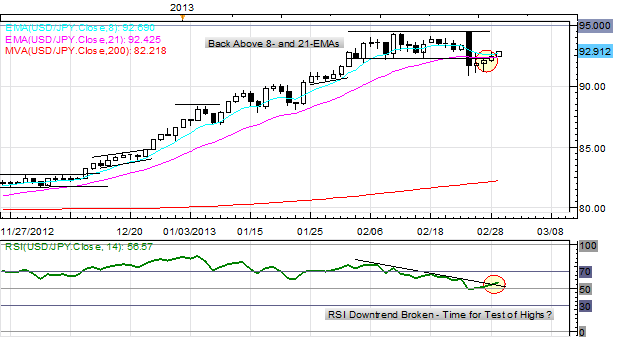
USDJPY: I’ve maintained: “The Bull Flag turned out to be a topping pattern, with the 92.30-94.80 range breaking to the downside. Now, with momentum heading lower, and significant event risk on tap, further selling into 90.00/20 would not be a surprise. Barring a collapse in Treasury yields (specifically, the 2s10s spread), the USDJPY remains a long-term buy.” Treasury yields have not collapsed despite the pullback in the S&P 500, and now the USDJPY has rallied above its 8- and 21-EMAs. I’m decisively neutral for now.
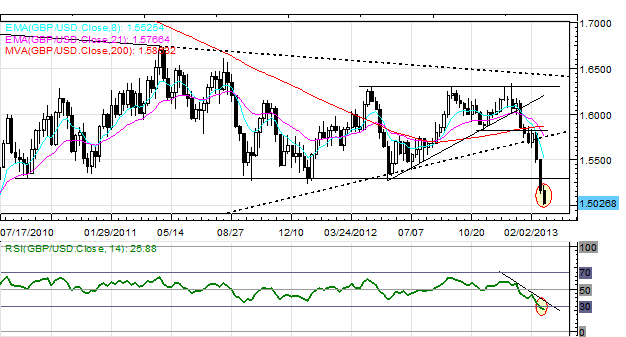
GBPUSD: I maintain: “Selling persists amid weak data, a dovish and divided Bank of England, and the United Kingdom losing its revered ‘Aaa’ rating. The opening gap this week was filled at 1.5160 after opening at 1.5072, suggesting that further downside may be in the cards. With uncertainty prevalent on the horizon – the US budget sequester coming on Friday – and the Federal Reserve tilting more hawkish, it’s possible to see a break below 1.5000 this week. With the ascending trendline off of the 2009 and 2010 lows breaking, as well as the 2010 to 2013 range bottom lows breaking near 1.5300, my bias is to sell rallies.” Fresh 2013 lows were hit today at 1.5025, at the time this report was written. Further downside is expected.
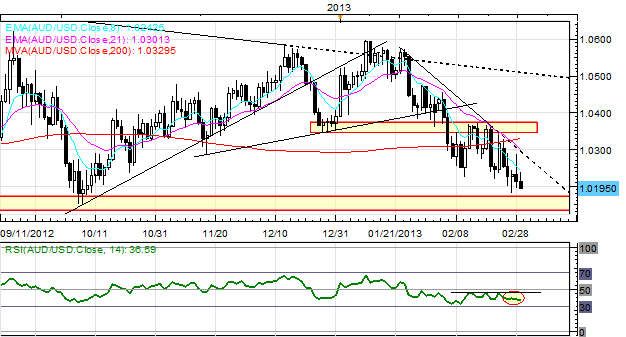
AUDUSD:No change: “The bounce from the 1.0265/90 area may have completed, with the rally halted at the 200-DMA at 1.0305/10. Although there was an overshoot into 1.0360, former support, failure has occurred, signaling further downside is possible…I’m still looking for a move into 1.0135/75…Selling has persisted as anticipated despite a two week respite; interaction in the 1.0135/75 zone is key for future action. I anticipate a violent break for a move below parity. Price has steadied just above this region, for now. Only a move back above 1.0345/75 negates the bearish bias.”
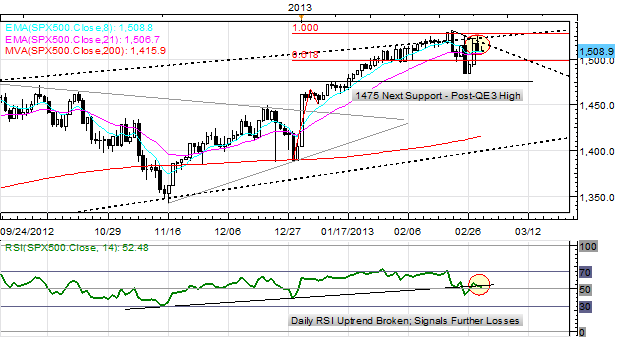
S&P 500: No change: “The 100% Fibonacci extension on the fiscal cliff rally and flag comes in at 1530. Bottom line: I’m expecting a significant setback (-10%) in the S&P 500 unless volumes accelerate rapidly, given the disconnect from reality. The setback has started, with the S&P 500 reversing sharply off of 1530, and putting in a daily Bearish Key Reversal yesterday. Time to start looking lower. Support comes in at 1500 and 1475. Resistance is 1520 and 1530.” 1475 is in focus now – the post-QE3 announcement highs in September.
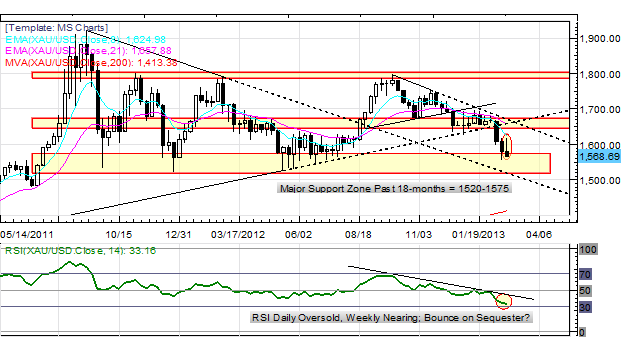
GOLD: No change: “Gold broke below trendline support off of the January 2011 and May 2012 lows at 1650 last week, prompting a sharp sell-off into 1600, where price broke out in mid-August before a rally into the post-QE3 high at 1785/1805. However, with oversold conditions persisting on the 4H and daily timeframes, a rebound should not be ruled out; each of the past two daily RSI oversold readings has produced a rally in short order. Resistance is 1625 and 1645/50. Support is 1585 and 1555/60. It should be noted that Gold has entered a major support zone from the past 18-months from 1520 to 1575.”
--- Written by Christopher Vecchio, Currency Analyst
To contact Christopher Vecchio, e-mail cvecchio@dailyfx.com
Follow him on Twitter at @CVecchioFX
To be added to Christopher’s e-mail distribution list, please fill out this form
DailyFX provides forex news and technical analysis on the trends that influence the global currency markets.
Learn forex trading with a free practice account and trading charts from FXCM.

